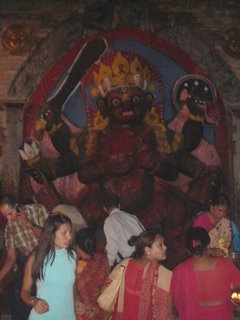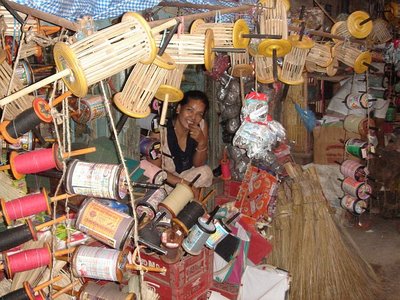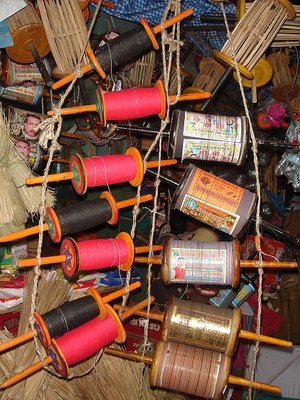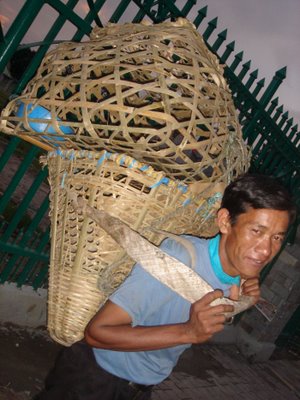Kathmandu, Nepal
Classic, the last few days. For three
 days I couldn't log into Blogger
days I couldn't log into Bloggerat all.
I even had my personal techno wizard Double T of Black Cats Manor on the case.
By the time he figured it out, the wi-fi a the wi-fi cafe was down. "Not our fault," the guy behind the counter assured me. "This Worldlink fault." That really makes me feel so much better about not meeting deadlines and leaving correspondence unanswered.
Then yesterday, there was a breakthrough. The Wi-fi was working, *and* Blogger was working. Victory!
A short-lived victory. I typed for one hour, then the power went out, and stayed that way till closing time. I packed up and went home, feeling very Blogged down.
Chariots of the Gods
Today I went down to Basantapur Square to see the fixin's for the upcoming Indra Jatra festival. The ancient chariots that will carry Kumari, the Living Goddess, as well as the kumaris of neighboring Patan and Bhaktapur, have been assembled near Kumari Ghar. They look like something from a fairy tale - a giant's jewelbox on wheels, their many-tiered pagoda roofs and intricate fittings made of carved teakwood and ornate brass.
Local people touch the chariots ("ratha") reverentially, then touch their own foreheads, as they strolled past on their way home at dusk.
The ferocious Kal Bhairav shrine (below) was glowing with butter la
 mps. Kal Bhairav ("black wrathful manifestation of Shiva") is the protector deity of Nepal. The shrine-keeping crone told me "two rupees" for a lamp, then a greasy-haired man came along and tried to charge five rupees. The old woman scolded him, which I found gratifying.
mps. Kal Bhairav ("black wrathful manifestation of Shiva") is the protector deity of Nepal. The shrine-keeping crone told me "two rupees" for a lamp, then a greasy-haired man came along and tried to charge five rupees. The old woman scolded him, which I found gratifying.I climbed the giant plinths of a Durbar Square temple, steep steps like Mayan pyramids, and watched the people scurrying home with parcels of fresh vegetables and chicken carcasses.
In nearby Kot Square, part of the old royal palace, some hundreds of buffalo and goats will be ritually slaughtered as part of the Dasain festival in late September. This slaughter is considered critically important to maintain the safety and well-being of the kingdom (if you can still call it that). I guess the comparison with Mayan pyramids isn't too far off after all.
Kite-flying season is upon us. In the fall, it's the tradition to fly diamond-shaped paper kites, probably because at that time the monsoon is finally over. There's even a six-day (three consecutive weekends) kite-flying competition at Nagarkot, called Changa Chait. Local companies sponsor rival kite-flying teams, like American corporate baseball.
The street stalls are full of wooden kite-string reels. The kite string is embedded with tiny bits of glass so the Fighting Kites can cut one another down. Talk about cutthroat competition! It always reminds me Charlie Brown and the evil kite-eating tree, except in this case it's evil, cannibalistic kite-eating kites.


Then it started to rain - lightly at first, till it was torrents. I took shelter inside the Buddhist courtyard temple of Seto Macchendranath, a god ironically associated with rainfall.
Giant palmetto bugs began crawling around the entry foyer to the temple. I just couldn't wait any longer and as the rain slacked a bit, I decided to head for home. The water, washing in huge lakes-full over semi-paved streets where minutes before people had been spitting, peeing and slicing up dead animals, was up to my ankles. I was glad I got my typhoid shot.
Exposure
Kamat's Potpourri has reprinted one of the "role reversal" photos I took in Andhra Pradesh with Vijay Sekuru.
Valley Vistas
My friend Ranjit is an entrepreneur here from Canada. He is setting up a BPO call-centre in Kathmandu, called Linktree. He has experience from working with Mphasis in Pune and decided he liked Nepal enough to set up shop here.
Last Sunday, we went on a drive (Ranjit has a car, with air conditioning. To a budget traveler like myself, this is a real treat)to Chobar, just outside the city. We never did find the Chobar Village Resort we were looking for...but got some beautiful views around the valley anyway.
You can really see why they call it "The Emerald Valley" - especially during monsoon, it's a lush (if mushy and marshy) green and misty blue marvel of fertility. The photos don't even do justice to the squares of shocking-green verdant rice paddy, but I did my best.




Funky Chicken
This man was on his way home, near Naya Sadak (New Road) at KulaManch. He's a fowler, or chicken vendor. He had sold all his chickens so the wicker baskets were empty.
He was chatting with a friend who spoke some English, so I asked the friend, "how much for one chicken?" They discussed it briefly.
"Three hundred, four hundred rupees," the friend interpreted. (That's about five dollars.)
"Isn't he afraid of bird flu?" I asked.
"Some six months after, he was afraid," (I knew what he meant - six months ago. After, since, before and ago get confused a lot) "but now no more bird flu." I wondered how he could be so sure.














No comments:
Post a Comment